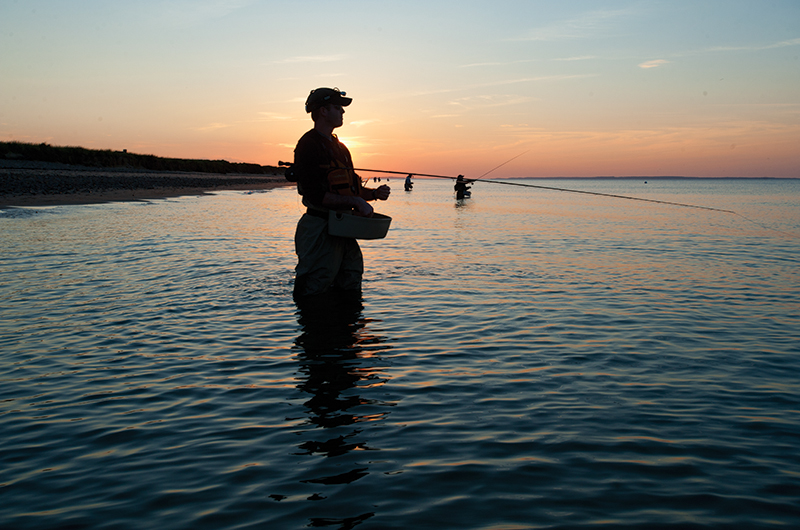Spring is my favorite time of the year to fish on Martha’s Vineyard. It is uncomplicated. The roads and beaches are not clogged with summer visitors and the single-minded pursuit of a big fish – or any fish – in the annual Striped Bass and Bluefish Derby is still months away.
A natural optimism attends the arrival of each new fishing season. Winter dormancy dominated by BBC reruns and Netflix has erased the memories of last year’s fishless spots. The slate is wiped clean and in my mind every fishy location from Gay Head to Wasque – a jetty, a cluster of rocks, an inlet, a sandy point – holds possibilities.
Spring is something of a misnomer on Martha’s Vineyard with respect to the weather, which is often cool and damp – I imagine like summer in Seattle. The prevailing southwest winds that will eventually bring warmth to our shores still carry the chill of an ocean throwing off winter’s embrace.
Striped bass, guided by their own internal clock and not my comfort zone, begin to filter into Island waters about the same time as the lilacs bloom. Rampaging bluefish may turn up off any Island beach or great pond opening and add to the excitement. It is a great time to go fishing, even if just for a few hours after dinner.
Fly rod or spinning rod, I prefer to travel light so as to walk more easily along the beach. I do not carry a tackle box the size of carry-on luggage or an encyclopedia collection of flies. I am a fishing minimalist.
A seven-foot St. Croix spinning rod outfitted with a Penn Battles reel and a handful of Sluggos, soft plastic worm-like lures: in my pocket is all I need to spend a few hours as the sun sets. For fly fishing an eight-weight rod is more than adequate for the spring striper run, when most of the fish are in the twenty-inch schoolie range.
There are exceptions. Last June I was fishing with friends at Lobsterville Beach as schoolie-sized stripers swirled up and down the beach. Lobsterville is a prime spring fishing destination: the gradual slope of the beach, abundance of bait, and position in the lee of a southwest wind make it one of the most productive and fly-fishing-friendly beaches on the Island. Its one drawback is limited parking.
I was casting a small black sand eel I had tied earlier that day and having good success since shortly after sunset. After several hours I was starting to tire, so I walked up the beach where my friend Cooper “Coop” Gilkes of Edgartown was fishing with two young employees from his tackle shop. “There are some nice fish in here, Bud,” Coop said to me, as though he were sharing a secret. “I just released one near forty inches.”
“Oh yeah, big fish,” I said, mocking Coop as I purposely stood to his right so he was unable to cast. Having had my fun I moved away about ten yards and cast.
The water exploded in front of me. The fish held for a moment and then took off in a long straight run, the hallmark of a big fish, and turned up the beach. I followed, knowing that Coop was wearing a self-satisfied smile. The fish, once landed, measured in excess of forty inches.
In recent years catching a big striped bass from the shore has been more the exception than the rule. However, the relative abundance of schoolie stripers in the spring provides a wonderful opportunity for fly fishermen who prefer to tie their own flies and experiment with patterns. Better fly tiers, of which there are many on the Island, carry a collection of flies that are as beautiful as they are effective. But my striper fly box selection is built around a utilitarian collection of squid and sand eel imitations.
The sand eel fly that proved to be so effective on Lobsterville that night was constructed on a small saltwater hook by inserting a small quantity of black fibers and reflective fibers inside a section of flexible black tubing, adding some eyes, and tying it off. The pattern is a far cry from the artistic beauty of a hand-tied salmon fly, but it works.
Or, I should say, it worked that night. Experienced fishermen know that bass may be extremely selective, choosing to strike a fly based on criteria that can be maddeningly hard to discern. One fisherman will draw strike after strike while another catches nothing. Is the deciding factor profile, color, size, or karma? Who knows. But it sure is exasperating to be on the wrong side of that equation, and very rewarding if you are the sleuth who hooks up.
I tend to resist changing flies in the face of selective fish. Some nights it is because I have confidence in my choice of fly pattern, and other nights it is because I am just stubborn. But my belief in the fisherman’s creed of one more cast seldom wavers. Standing on an Island beach holding a fishing rod in your hands in the spring is no time to be a pessimist.





